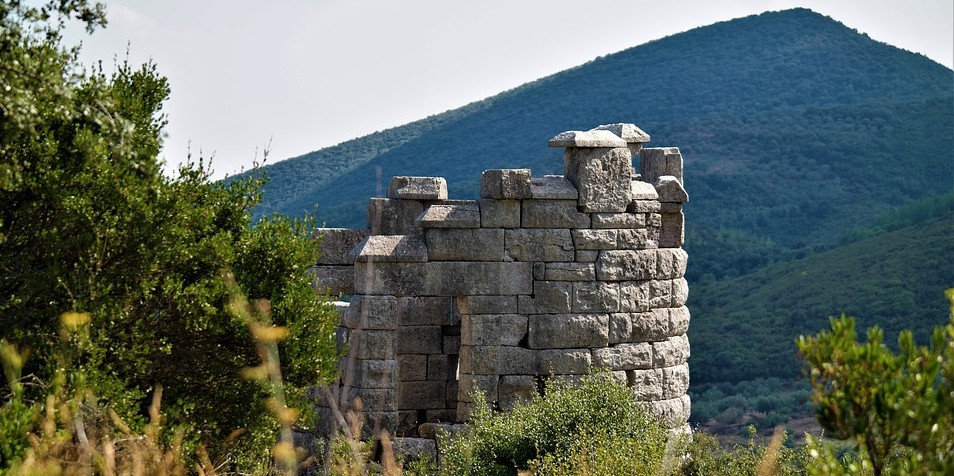Messenia is a regional unit of Greece situated in the southwestern part of the Peloponnese peninsula. It is a historical kingdom which was annexed by Sparta during the Peloponnesian War, its people being enslaved and their home transformed into a war factory for Peloponnesian League. Prior to the Spartan conquest, Messenia was a prosperous land with lush vegetation. During the Peloponnesian War the Spartans mobilized all of the region's resources towards its war effort, and its environment was devastated by the unfettered exploitation of its resources. Factories and warehouses for the mass production of military equipment and siege weapons dominated the area, leading to overmining and deforestation.Today, Messenia is a pretty region of modern Greece. It is home to beautiful beaches with golden sand and crystal clear waters, endless groves and vineyards, and castles with rich history.
The coastline of Messinia features several beautiful beaches, including Stoupa, Finikouda, Kalogria, Velika and the omega-shaped Voidokilia, in the Gialova Lagoon, with its diverse fauna and flora. Their natural beauty, low-key vibes and length will certainly entice you to spend the whole day by the water. If you drop by Voidokilia, don’t forget to check out the mythical Nestor’s Cave, where Hermes is said to have hidden the cattle he stole from Apollo. Messinia has its own set of islands, including the small but beautiful Proti, a paradise for history buffs right across Marathopoli. Despite its small size, the island features some archeological sites of ancient temples, the ruins of a citadel, an acropolis from pre-classical and Mycenean times and the monastery of Panagia Gorgopigi. Thanks to its good visibility, it is also home to a dozen dive sites where you can spot turtles, coral, sponges rays and damselfish. Messinia is filled with ancient sites, including the Palace of Nestor and the ancient city of Messene. The Palace of Nestor is one of the most well-preserved Mycenean structures still visible today. Located 14 kilometers (8.5 miles) from Pylos, the palace was built by King Nestor, son of Neleus, and features in both the Iliad and the Odyssey. Comprising several sections and built on two floors, the palace was destroyed by fire in the late 13th century BCE and was never rebuilt, but many of the artifacts were recovered and are now on display at the Archaeological Museum of Chora and at the Archaeological Museum of Messenia, in Kalamata. Ancient Messene is another fascinating site, with some temples, residential houses and public buildings still standing.
The coastline of Messinia features several beautiful beaches, including Stoupa, Finikouda, Kalogria, Velika and the omega-shaped Voidokilia, in the Gialova Lagoon, with its diverse fauna and flora. Their natural beauty, low-key vibes and length will certainly entice you to spend the whole day by the water. If you drop by Voidokilia, don’t forget to check out the mythical Nestor’s Cave, where Hermes is said to have hidden the cattle he stole from Apollo. Messinia has its own set of islands, including the small but beautiful Proti, a paradise for history buffs right across Marathopoli. Despite its small size, the island features some archeological sites of ancient temples, the ruins of a citadel, an acropolis from pre-classical and Mycenean times and the monastery of Panagia Gorgopigi. Thanks to its good visibility, it is also home to a dozen dive sites where you can spot turtles, coral, sponges rays and damselfish. Messinia is filled with ancient sites, including the Palace of Nestor and the ancient city of Messene. The Palace of Nestor is one of the most well-preserved Mycenean structures still visible today. Located 14 kilometers (8.5 miles) from Pylos, the palace was built by King Nestor, son of Neleus, and features in both the Iliad and the Odyssey. Comprising several sections and built on two floors, the palace was destroyed by fire in the late 13th century BCE and was never rebuilt, but many of the artifacts were recovered and are now on display at the Archaeological Museum of Chora and at the Archaeological Museum of Messenia, in Kalamata. Ancient Messene is another fascinating site, with some temples, residential houses and public buildings still standing.


